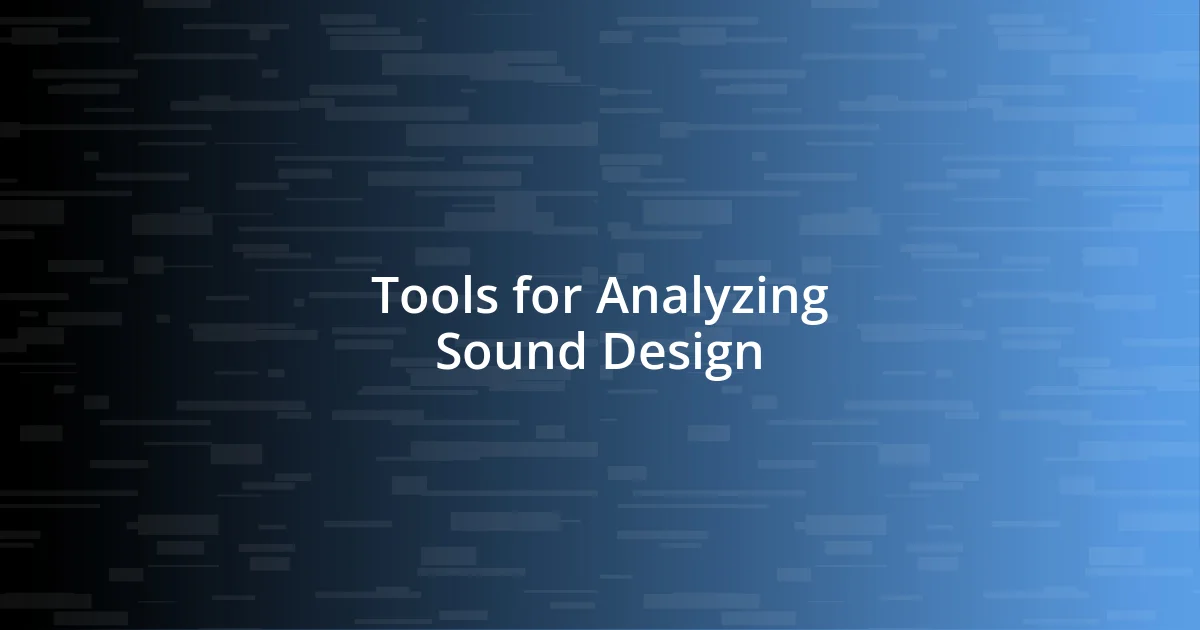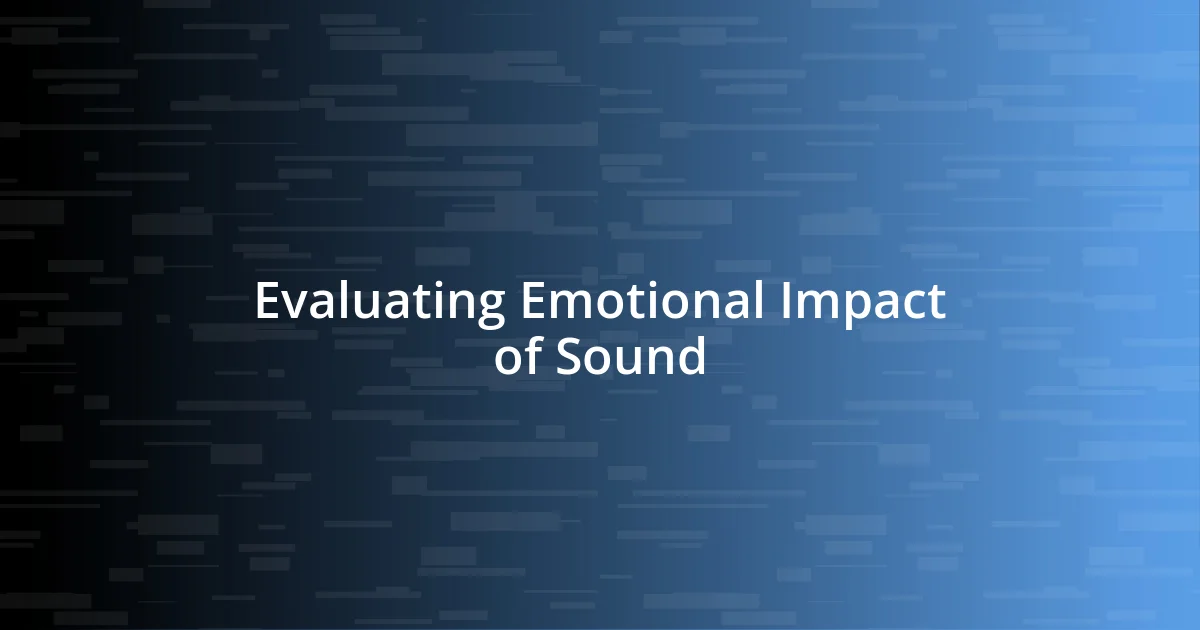Key takeaways:
- Sound design in film significantly influences emotional responses, using elements such as silence, ambient sounds, and layered audio to create immersion and depth.
- Key components of sound analysis include dialogue clarity, sound effects, music scores, and the strategic use of silence, all contributing to the overall storytelling experience.
- Practical techniques for effective sound analysis involve active listening, context-based analysis, and comparative analysis between different films, enhancing understanding of artistic choices in sound design.

Understanding Film Sound Design
Film sound design is an intricate art that often goes unnoticed, yet it profoundly shapes our emotional response to a scene. I remember watching a thriller where the absence of sound during a tense moment amplified my heart rate—just a single creaking door sent chills down my spine. Isn’t it fascinating how silence can be just as powerful as a booming score?
While we often focus on dialogue and music, sound effects play a crucial role in building the film’s world. I once analyzed a film where footsteps on gravel not only provided realism but also conveyed the character’s uncertain journey. How do these small auditory details affect your perception of a storyline?
Furthermore, layering different sounds is essential for creating depth. I’ve often found myself captivated by how background sounds can enhance the foreground action, making a scene feel more immersive. Have you ever noticed how the gentle rustle of leaves can transport you right into the heart of a forest scene? It’s moments like these that truly highlight the genius behind sound design in film.

Key Elements of Sound Analysis
When analyzing film sound design, several key elements come into play that really shape how we experience a movie. Firstly, let’s consider the role of ambient sounds. I recall watching a classic Western film where the distant sounds of a train provided a sense of time and place, adding depth to the unfolding story. It’s incredible how these subtle elements evoke nostalgia and ground us within the film’s universe.
Here’s a quick breakdown of the essential components to focus on:
- Dialogue: The clarity and delivery impact how we connect with characters.
- Sound Effects: These bring realism and can foreshadow events or enhance emotional responses.
- Music Scores: They set the mood, guiding our emotional journey throughout the film.
- Silence: This can heighten tension or invoke a reflective pause, making the audience lean in.
- Ambience: Background sounds establish the setting and context, immersing us in the scene.
Each element weaves together to form a rich tapestry, influencing our perception and emotional engagement. Just thinking about those intricate layers excites me, because that’s what makes the experience of film so unique!

Tools for Analyzing Sound Design
Analyzing sound design takes more than just attentive listening; it requires the right tools to unpack the layers of audio intricacy. Software like Pro Tools and Adobe Audition allows for detailed sound editing and analysis. I fondly remember the first time I used these platforms, feeling empowered to manipulate sound elements in ways I never thought possible. With such tools, I could isolate sound tracks, tweak frequencies, and as a result, discover nuances that dramatically altered my understanding of the film’s emotional landscape.
In addition to software, analyzing sound design can also benefit from hardware tools. Using high-quality headphones or studio monitors makes a significant difference in perception. I often find myself switching between my everyday headphones and my studio-grade monitors to catch differences in sound balance and clarity. It’s quite revealing—the subtleties are astonishing, and I’m always surprised at what I might miss on lesser gear. Compare these tools based on their functionality, accessibility, and the depth of analysis they allow, and you’ll start to see how they enhance your overall viewing experience.
Here’s a comparison table summarizing key tools for analyzing sound design:
| Tool Type | Examples |
|---|---|
| Software | Pro Tools, Adobe Audition |
| Hardware | High-Quality Headphones, Studio Monitors |

Techniques for Effective Sound Analysis
When it comes to effective sound analysis, one technique I rely on is active listening. This means tuning into not just the dominant audio elements, like dialogue or music, but also the subtler sounds that might be easy to overlook. I remember watching a suspenseful thriller where a creaking door wasn’t just an effect; it created an atmosphere of tension that really made my heart race. Taking the time to notice these details transforms sound analysis into more than a task; it turns it into an immersive experience.
Another technique I find invaluable is context-based analysis. It’s fascinating to consider how sound design interacts with visual storytelling. For example, I once analyzed a romantic scene in a film where the background score swelled perfectly with the first kiss on screen. The audio amplified the emotion and made the moment unforgettable. Was it the score alone, or did the choice of silence before the kiss heighten the impact? Understanding how these choices shape narrative moments provides deeper insight into the filmmaker’s intentions.
I also engage in comparative analysis when analyzing sound. This involves comparing sound elements from one film to another, which helps highlight different stylistic choices. I often think about how Quentin Tarantino’s films utilize sound in stark contrast to a more traditional score-driven approach found in a Spielberg film. Which sounds linger in my mind more vividly? By asking these questions, I peel back layers of artistic intent, revealing the rich tapestry of cinematic sound design that so often goes unrecognized.

Evaluating Emotional Impact of Sound
Evaluating the emotional impact of sound in film is undeniably fascinating. I recall watching a powerful drama where the lingering notes of a piano echoed throughout a pivotal scene. It wasn’t just music; it transformed my emotions, deepening the pain of the character’s loss. The sound lingered with me long after the credits rolled, prompting me to consider: can sound alone evoke such palpable feelings? Absolutely, and it often does.
In another instance, I watched a horror film that used silence masterfully. Right before a character encountered an unseen threat, the abrupt absence of sound created a dread that was almost tangible. I remember holding my breath, lost in that eerie stillness. It made me question conventional wisdom: Is it the sound that drives emotion, or can silence be just as powerful? The answer lies in how sound is used to manipulate our feelings, revealing the delicate balance between audio and emotion.
Some sounds become symbols of specific emotions, affecting how I experience a film. Take, for example, the sound of rain in a sad scene; it evokes a sense of melancholy that amplifies the visuals. I once analyzed a film where the rain sounded almost comforting despite the heartbreak on screen. Did I feel sadness, or was it the rain soothing my emotional turmoil? This interplay illustrates how sound shapes our responses, making it essential to reflect on how these elements meld with the narrative to create an immersive emotional journey.

Case Studies in Film Sound Design
When I examine case studies in film sound design, I often reflect on “A Quiet Place” and its groundbreaking use of silence. This film relies heavily on the absence of sound to heighten tension, pulling me right into the suspenseful world of the characters. I remember being on the edge of my seat, wondering: how can a film that embraces silence speak so loudly through fear? The decision to craft a soundscape that almost demands stillness showcases the power of sound, or its lack thereof, in creating a gripping narrative.
Another standout example is the intricate sound design in “Inception.” The layers of auditory elements, from the iconic “BRAHAM” to the whispers of dreams collapsing, genuinely engrossed me as a viewer. It made me question how sound can bend the perception of time and reality. That moment when the score swells just as the plot thickens leaves a lasting impression—doesn’t it feel like the sound itself is an active participant in the storytelling?
I also think about “Mad Max: Fury Road,” renowned for its frenetic auditory chaos. The sound design plays a crucial role in conveying the film’s relentless energy. I can still feel the roar of engines vibrating through the theater, an exhilarating reminder of how sound can turn a film into an experience. Did the sound make me part of that high-octane chase, or did it simply amplify the visuals? It’s a testament to how sound complements—sometimes even drives—visual storytelling, reinforcing my belief that analyzing sound design opens up entirely new dimensions of film.

Applying Insights to Your Work
When I think about applying insights from sound design, I can’t help but reflect on my own projects. There was a short film I worked on where we chose a subtle, continuous drone to create an atmosphere of unease. The feedback was astounding! Viewers felt the tension even before the key scenes unfolded. It made me realize how a well-placed sound can shape audience perception long before any visuals hit the screen. Isn’t that amazing?
In another instance, I experimented with layering ambient sounds to enhance a scene’s authenticity. During a café scene, I incorporated faint chatter and clinking cups. This little detail didn’t just fill the silence; it pulled the audience into the setting, making them feel like they were part of the narrative. It got me wondering: how many creators overlook these auditory nuances that can drastically elevate their storytelling?
I’ve also learned the power of sound in building character identity. In one of my projects, I used a character’s unique sound signature—a specific melody that played during their appearances. It became a way for the audience to connect emotionally without uttering a single word. Reflecting on this, it’s incredible how sound not only supports visuals but can also serve as a narrative device itself. How can your own work embrace the auditory storytelling that sounds often convey?














